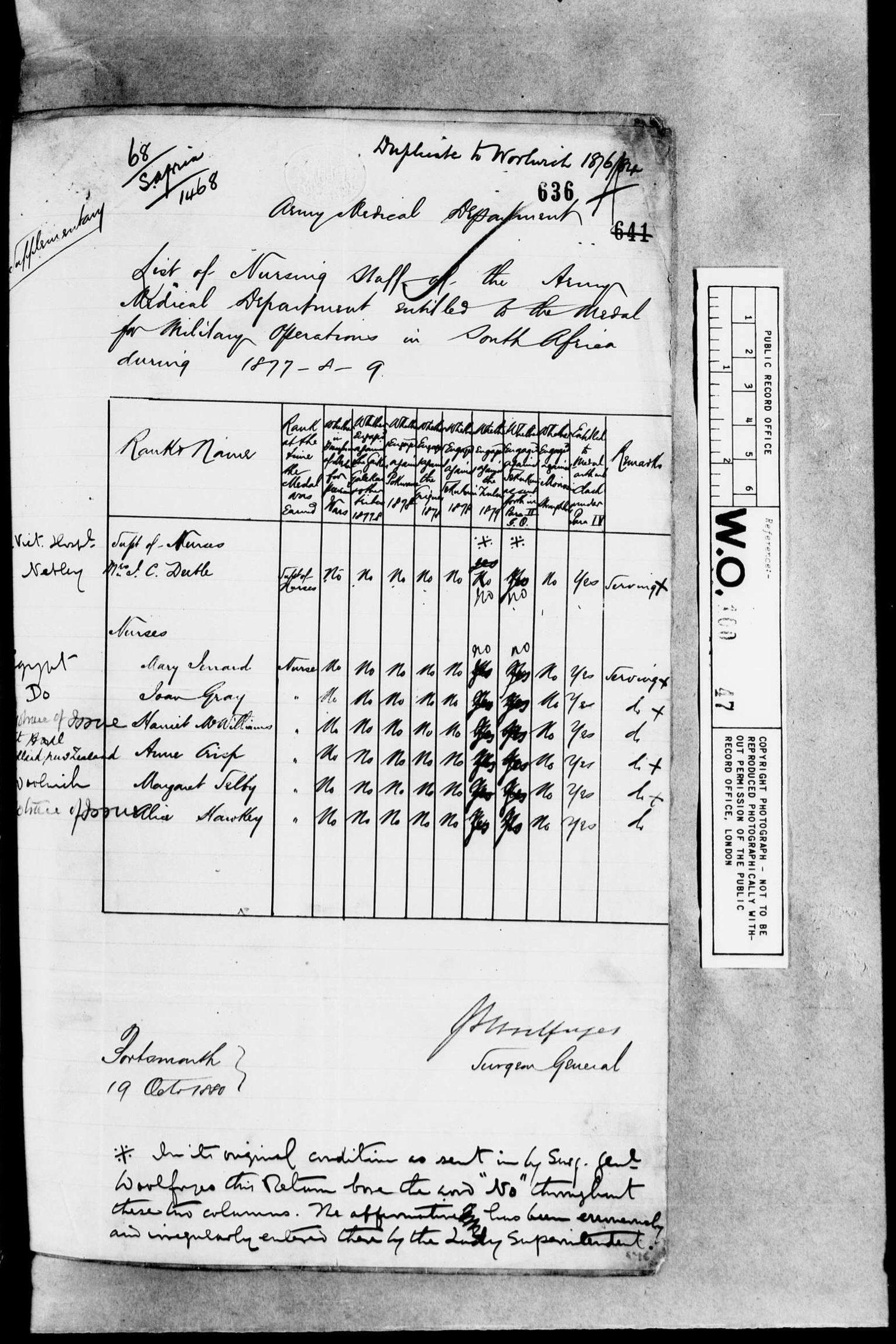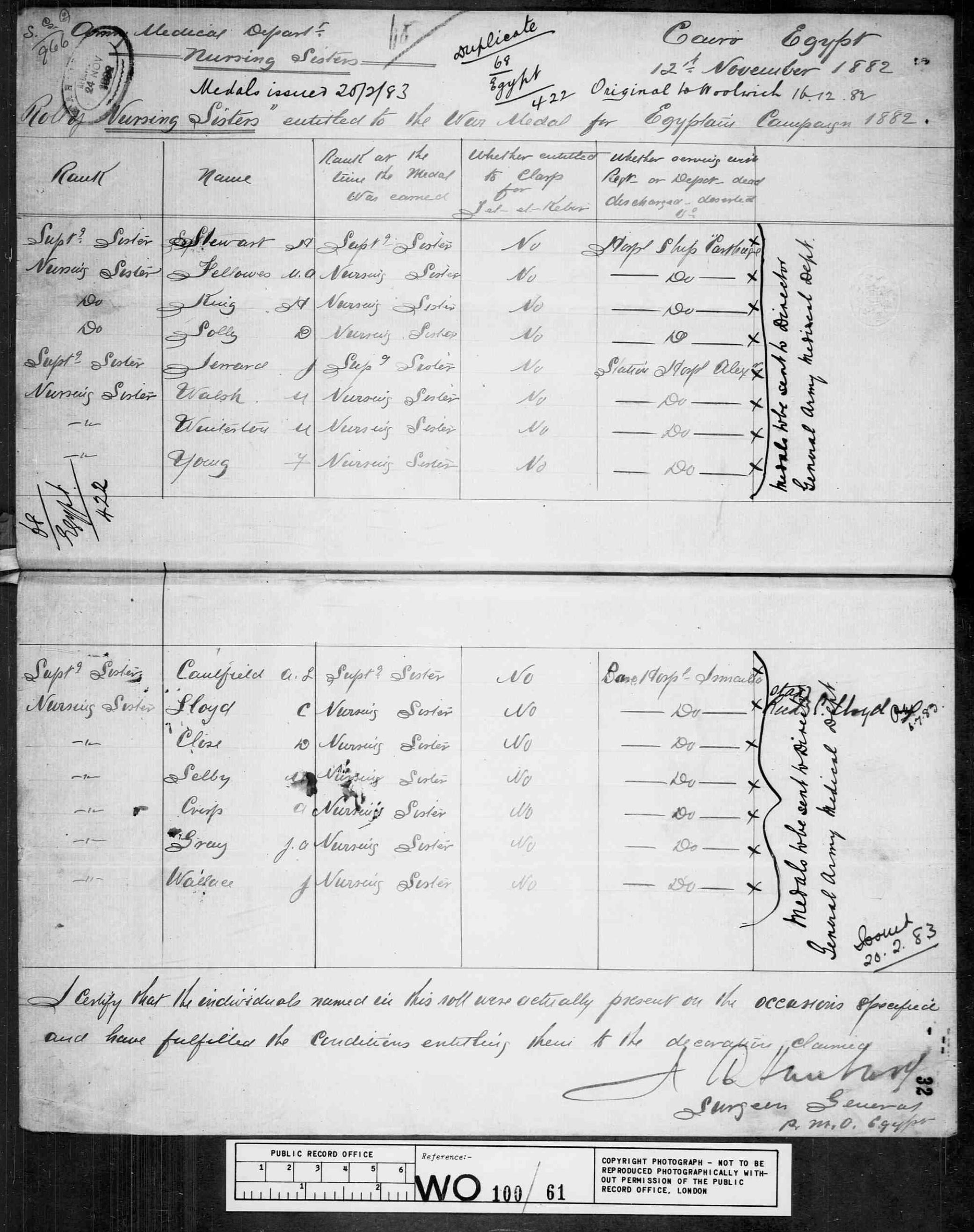Victorian Wars Medal Rolls
Context
In 1881 the Army Nursing Service (ANS) was formed. Nurses wore military uniform and were employed directly to care for military patients[1] [2]. The ANS, although nominally a military formation was not an established part of the Army and did not sit within any of the directorates of the War Office.
The Medal Rolls
Army Nursing sisters served in support of many of the campaigns that took place between the Crimean War and the Boer War. The Army fought campaigns in Abyssinia (1868) (what is now Ethiopia on the Horn of Africa), a series of campaigns against the Ashanti on the Gold Coast (what is now Ghana, West Africa); The Anglo-Basuto War (1879-81) (in what is now Lesotho in South Africa); the Zulu War (1878-1879) (in what is now KwaZulu-Natal in South Africa) the Transvaal War (1880-1881) (Transvaal in South Africa); a long campaign in Egypt and the Sudan (1882-1888); the Matabele War (1893-94) (in what is now Zimbabwe); and another campaign in the Sudan (1896-98).
There are records of the service of Army Nursing Service Sisters in the medal rolls for these campaigns, as well as some accounts of their activities in nursing journals and official reports of the time. Nurses are mentioned in some of the historical accounts of the period, for example during the Ashanti campaigns[3].
South Africa (Zulu War)
During the Zulu War there were a number of base hospitals including Durban, Pietermaritzburg, Ladysmith, Utrecht and Newcastle. Most of the sickness that occurred was from enteric fevers, something that was to be repeated in the Boer War[4].
Below is one of the pages from the medal roll for the campaign in South Africa. It is one of the two occasions where nurses appeared on the medal rolls. You can see that they are annotated as being Nursing Staff of the Medical Department as there was no separate Nursing Department at this time.
You will also see that there are some alterations to the document. Nursing Sisters have never been authorised to wear clasps that depict specific battles on their campaign medals as they were (and are still) regarded as non-combatant.
The nurses listed are:
- Lady Superintendent Mrs JC. Deeble
- Nurse Mary Leonard
- Nurse Jane Gray
- Nurse Harriet Williams
- Nurse Anne Crisp
- Nurse Margaret Selby
- Nurse Alice Hawtley
The only one of these to still be serving at the time of the Boer War (1899-1902) is Jane Gray.
Egyptian Campaign
During the Egyptian campaigns (1882-1888) there were eight Field Hospitals (nominally of 200 beds) and two Base Hospitals (nominally of 500 beds) Two Hospital Ships were stationed at Ismailia – the Carthage, and the Courland[5]. A total of 25 ANS nurses were sent out from England to support the medical care to the sick and wounded.
Below is one of the pages from the medal roll for the campaign in Egypt, the only other medal roll that exists for this period.
From this page, plus pages 48&49, we can see that four nurses were allocated to the Hospital Ship Carthage (Superintendent Stewart, Sisters Fellowes, King and Solly). Four nurses were sent to the Base Hospital at Alexandria (Superintendent Jerrard, Sisters Walsh, Winterton and Young). Seven nurses served at the other Base Hospital in Ismailia (Superintendent Caulfield, Sisters Lloyd, Close, Selby, Crisp, Gray and Wallace). As you can see, some of these nurses also served in South Africa.
A Superintendent and four nurses were also based at each of the hospitals in Cyprus and Gozo[5].
A list of Army Nursing Service nurses is being created at: [Category:Victorian]
References
- ↑ Bett, WR. (1960) A Short History of Nursing. London: Faber and Faber
- ↑ Taylor, E (2001) Wartime Nurse: One Hundred Years from the Crimea to Korea 1854-1954 London: Robert Hale
- ↑ Claridge, WW. (1915) A History of the Gold Coast and Ashanti from the earliest times to the commencement of the twentieth century. London: John Murray
- ↑ Woolfryes, Surgeon-General J.A. (1879) Medical History of the War in Zululand, 1879. Army Medical Department Report. London: HMSO
- ↑ 5.0 5.1 Goodrich, C. F. (1883). Report of the British naval and military operations in Egypt, 1882. Washington: G.P.O..
Further Resources
McGann, S. (1992) The Battle of the Nurses. London: Scutari Press
The National Archives: WO 100/47 p32 Medal roll for South Africa 1877-79
The National Archives: WO 100/61 p32 Medal roll for Egypt (Base Hospital Ismalia)
The National Archives: WO 100/61 p32 Medal roll for Egypt (Station Hospital Alexandria)
The National Archives: WO 100/61 p32 Medal roll for Egypt (Hospital Ship Carthage)
Nursing Record (1893) At Home: Miss Norman at the Royal Victoria Hospital, Netley. Nursing Record. July 6, 1893, 329-331
Nursing Record & Hospital World (1895) Nurses of Note: Superintendent Sister J. A. Gray. Nursing Record & Hospital World Dec 14. pp.428-429
Nursing Record & Hospital World (1896) Interview with Sister Gray. Nursing Record & Hospital World Mar 7. pp.188-189
Nursing Record & Hospital World (1899) Commentary. Nursing Record & Hospital World. Dec 23. pp.511
War Office (1898) The Army List, September 1898. London: HMSO


